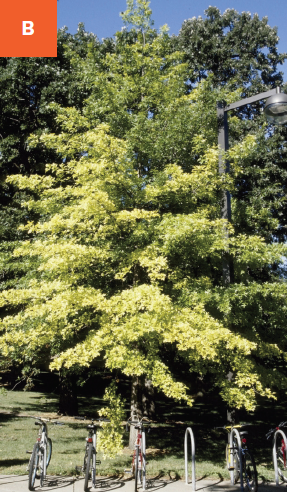Leaf Chlorosis
DAMAGE/SYMPTOMS Leaf chlorosis generally progresses from light green earlier in the season to yellow later in the season. Leaf veins may remain bright green while the leaf tissue yellows. Advanced stages of chlorosis can cause reduced leaf size, browning of the leaf margins, subsequent tissue deterioration, and premature leaf drop.
OCCURRENCE Chlorosis can be caused by a single issue such as a nutrient deficiency, but more commonly it is due to multiple factors influencing the health of the plant. Drought, over watering, compacted soils, limited planting areas, and poorly drained soils can impact a plant’s vulnerability to chlorosis. Soil pH can influence leaf chlorosis because it has a significant role in a plant’s ability to uptake available nutrients. For example, some nutrients such as iron can be less available to plants as soil pH increases.
SUSCEPTIBILITY/TOLERANCE Certain trees are more prone to chlorosis such as apple, maple, and poplar. Trees and shrubs that are more tolerant of alkaline soils and less likely to show leaf chlorosis are linden, ash, boxelder, oak, elm, hawthorn, and honeylocust.
MANAGEMENT Planting trees that are tolerant of alkaline soils is important in managing chlorosis. Supplemental watering during drought conditions can reduce tree stress and the risk of chlorosis. Removing grass at the base of trees will reduce the competition for water. Mulching with two to three inches of compost to retain soil moisture will also reduce the risk of chlorosis.
A Browning of leaf margins in advanced stages of chlorosis. B Certain tree species, like maple, are more susceptible to chlorosis. C Light green leaf tissue along with darker veins can indicate chlorosis.



